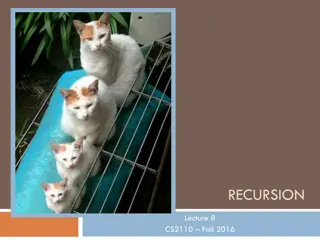Understanding Recursion in Java: CS2110 Lecture Overview
This content delves into the concept of recursion in the context of Java programming as discussed in the CS2110 Spring 2016 lecture series. It covers the basics of recursion, including base cases and how Java stack frames operate. The material also includes solutions to exception-handling problems and emphasizes the importance of TA midsemester evaluations. Additionally, it touches on topics such as the Hoare triple for if-statements and the execution of method calls in Java.
Download Presentation

Please find below an Image/Link to download the presentation.
The content on the website is provided AS IS for your information and personal use only. It may not be sold, licensed, or shared on other websites without obtaining consent from the author. Download presentation by click this link. If you encounter any issues during the download, it is possible that the publisher has removed the file from their server.
E N D
Presentation Transcript
RECURSION (CONTINUED) Lecture 9 CS2110 Spring 2016
Overview references to sections in text 2 Note: We ve covered everything in JavaSummary.pptx! What is recursion? 7.1-7.39 slide 1-7 Base case 7.1-7.10 slide 13 How Java stack frames work 7.8-7.10 slide 28-32 Solutions to exception-handling problem set: lecture-notes page, course website, row for recitation 3. A3 regrades will be done by end of weekend TA midsemester evaluation coming! PLEASE help us and complete the evaluations! A chance to help Tas and YOU this semester
About prelim 1 3 1. 5:30-7PM. Kennedy 116: last name begins with A..Lib. 2. 7:30-9:PM. Kennedy 116: last name begins with Lie..Z. 3. Gates 405 if authorized to have quiet room or more time. Complete P1Conflict on the CMS. Issue with this, see point 5. 4. Conflict with scheduled time but can make other one: Complete P1Conflict. Go to other prelim. 5. All other conflicts (e.g. won't be in town). Email Megan Gatch mlg34@cornell.edu. State name, netid, conflict clearly and thoroughly. Don t complete P1Conflict. We ll get back to you. Complete P1Conflict (if you have to) by end of 9 March.
Hoare triple for if-statement 4 What do we need to know this is true? {Q} if (B) S {R} But what if B is false? Doesn t R still have to be true after execution of the if-statement? Many of you wrote this: If {Q && B} S {R} and Q && !B => R then {Q} if (B) S {R}
Summary of method call execution: 5 1. Push frame for call onto call stack. 2. Assign arg values to pars. 3. Execute method body. p ____ 7 4. Pop frame from stack and (for a function) push return value on the stack. 8 k ____ For function call: When control given back to call, pop return value, use it as the value of the function call. public int m(int p) { int k= p+1; return p; } m(5+2) call stack
Summary of method call execution: 6 1. Push frame for call onto call stack. 2. Assign arg values to pars. 8 3. Execute method body. p ____ 7 4. Pop frame from stack and (for a function) push return value on the stack. 8 k ____ For function call: When control given back to call, pop return value, use it as the value of the function call. public int m(int p) { int k= p+1; return k; } m(5+2) call stack
Summary of method call execution: 7 1. Push frame for call onto call stack. 2. Assign arg values to pars. 3. Execute method body. 4. Pop frame from stack and (for a function) push return value on the stack. 8 For function call: When control given back to call, pop return value, use it as the value of the function call. public int m(int p) { int k= p+1; return k; } m(5+2) call stack
Understanding recursive methods 8 1. Have a precise specification 2. Check that the method works in the base case(s). 3. Look at the recursive case(s). In your mind, replace each recursive call by what it does according to the spec and verify correctness. 4. (No infinite recursion) Make sure that the args of recursive calls are in some sense smaller than the pars of the method
The Fibonacci Function 9 Mathematical definition: fib(0) = 0 fib(1) = 1 fib(n) = fib(n 1) + fib(n 2), n 2 two base cases! Fibonacci sequence: 0, 1, 1, 2, 3, 5, 8, 13, /** = fibonacci(n). Pre: n >= 0 */ staticint fib(int n) { if (n <= 1) return n; // { 1 < n } return fib(n-2) + fib(n-1); } Fibonacci (Leonardo Pisano) 1170-1240? Statue in Pisa, Italy Giovanni Paganucci 1863
Example: Count the es in a string 10 /** = number of times c occurs in s */ publicstaticint countEm(char c, String s) { if (s.length() == 0) return 0; substring s[1..], i.e. s[1], , s(s.length()-1) // { s has at least 1 character } if (s.charAt(0) != c) return countEm(c, s.substring(1)); // { first character of s is c} return 1 + countEm (c, s.substring(1)); } countEm( e , it is easy to see that this has many e s ) = 4 countEm( e , Mississippi ) = 0
Computing bn for n >= 0 11 Power computation: b0 = 1 If n != 0, bn = b * bn-1 If n != 0 and even, bn = (b*b)n/2 Judicious use of the third property gives far better algorithm Example: 38 = (3*3) * (3*3) * (3*3) * (3*3) = (3*3) 4
Computing bn for n >= 0 12 Power computation: a0 = 1 Suppose n = 16 Next recursive call: 8 Next recursive call: 4 Next recursive call: 2 Next recursive call: 1 Then 0 If n != 0, bn = b bn-1 If n != 0 and even, bn = (b*b)n/2 /** = b**n. Precondition: n >= 0 */ staticint power(double a, double n) { if (n == 0) return 1; if (n%2 == 0) return power(b*b, n/2); return b * power(b, n-1); } 16 = 2**4 Suppose n = 2**k Will make k + 2 calls
Computing bn for n >= 0 13 If n = 2**k k is called the logarithm (to base 2) of n: k = log n or k = log(n) Suppose n = 16 Next recursive call: 8 Next recursive call: 4 Next recursive call: 2 Next recursive call: 1 Then 0 /** = b**n. Precondition: n >= 0 */ staticint power(double a, double n) { if (n == 0) return 1; if (n%2 == 0) return power(b*a, b/2); return b * power(b, n-1); } 16 = 2**4 Suppose n = 2**k Will make k + 2 calls
Tiling Elaines kitchen 14 Kitchen in Gries s house: 8 x 8. Fridge sits on one of 1x1 squares His wife, Elaine, wants kitchen tiled with el-shaped tiles every square except where the refrigerator sits should be tiled. 8 /** tile a 23 by 23 kitchen with 1 square filled. */ public static void tile(int n) 8 We abstract away keeping track of where the filled square is, etc.
Tiling Elaines kitchen 15 /** tile a 2n by 2n kitchen with 1 square filled. */ public static void tile(int n) { if (n == 0) return; } Base case? We generalize to a 2n by 2n kitchen
Tiling Elaines kitchen 16 2n /** tile a 2n by 2n kitchen with 1 square filled. */ public static void tile(int n) { 2n if (n == 0) return; } n > 0. What can we do to get kitchens of size 2n-1 by 2n-1
Tiling Elaines kitchen 17 /** tile a 2n by 2n kitchen with 1 square filled. */ public static void tile(int n) { if (n == 0) return; } We can tile the upper-right 2n-1 by 2n-1 kitchen recursively. But we can t tile the other three because they don t have a filled square. What can we do? Remember, the idea is to tile the kitchen!
Tiling Elaines kitchen 18 /** tile a 2n by 2n kitchen with 1 square filled. */ public static void tile(int n) { if (n == 0) return; Place one tile so that each kitchen has one square filled; Tile upper left kitchen recursively; Tile upper right kitchen recursively; Tile lower left kitchen recursively; Tile lower right kitchen recursively; }
Sierpinski triangles 19 S triangle of depth 0 S triangle of depth 1: 3 S triangles of depth 0 drawn at the 3 vertices of the triangle S triangle of depth 2: 3 S triangles of depth 1 drawn at the 3 vertices of the triangle
Sierpinski triangles 20 S triangle of depth 0: the triangle S triangle of depth d at points p1, p2, p3: 3 S triangles of depth d-1 drawn at at p1, p2, p3 p3 Sierpinski triangles of depth d-1 p2 p1
Conclusion 21 Recursion is a convenient and powerful way to define functions Problems that seem insurmountable can often be solved in a divide-and-conquer fashion: Reduce a big problem to smaller problems of the same kind, solve the smaller problems Recombine the solutions to smaller problems to form solution for big problem























